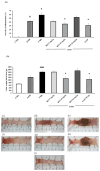Resveratrol Mitigates Inflammation by Modulating Tumor Necrosis Factor-Alpha Receptors (TNFRs) in a 2,4,6-Trinitrobenzene Sulfonic Acid (TNBS)-Induced Rat Model of Colitis
- PMID: 40565241
- PMCID: PMC12193490
- DOI: 10.3390/ijms26125779
Resveratrol Mitigates Inflammation by Modulating Tumor Necrosis Factor-Alpha Receptors (TNFRs) in a 2,4,6-Trinitrobenzene Sulfonic Acid (TNBS)-Induced Rat Model of Colitis
Abstract
Several substances with antioxidant and anti-inflammatory properties are currently being investigated as potential adjunctive or standalone treatments for inflammatory bowel disease (IBD). One such substance is resveratrol (RES), also known as 3,5,4'-trihydroxy-trans-stilbene, a natural dietary polyphenol with diverse health-promoting effects. In this study, male Wistar-Hannover rats received oral RES supplementation at doses of 5, 10, or 20 mg/kg/day for 28 days. On day 25 colitis was induced using intracolonic administration of 2,4,6-trinitrobenzene sulphonic acid (TNBS). Based on histological and planimetric analysis, the 10 mg/kg dose significantly reduced colonic ulceration and pro-inflammatory cytokine tumor necrosis factor-alpha (TNF-α) expression compared to the TNBS group. Immunohistochemistry also revealed that RES at this dose attenuated the intensity of TNF-α receptors, namely TNFR1 and TNFR2. Furthermore, the concentration of lipocalin-2 (Lcn-2) was significantly elevated in TNBS-induced colitis. In conclusion, our findings suggest that RES may exert its protective effects partly through the modulation of TNF receptor signaling in TNBS-induced colitis.
Keywords: IBD; TNBS-induced colitis; TNF-alpha; TNFR-α receptor; colon inflammation; oxidative stress; pro-inflammatory cytokine; resveratrol.
Conflict of interest statement
Authors Médea Veszelka, József Hegyközi, Nikoletta Almási and Csaba Varga, were employed by the company HR-Pharma Ltd., they do not have conflict of interest.
Figures










Similar articles
-
Chitosan nanoparticles of rutin mitigated histological changes induced in DNCB-induced colitis by enhanced modulation of inflammation and oxidative stress.J Mol Histol. 2025 Jun 21;56(4):200. doi: 10.1007/s10735-025-10491-7. J Mol Histol. 2025. PMID: 40542885
-
Transauricular vagal nerve stimulation suppresses inflammatory responses in the gut and brain in an inflammatory bowel disease model.J Anat. 2025 Apr;246(4):602-615. doi: 10.1111/joa.14178. Epub 2024 Dec 20. J Anat. 2025. PMID: 39707162
-
Evaluating the Anti-inflammatory Efficacy of a Novel Bipyrazole Derivative in Alleviating Symptoms of Experimental Colitis.Curr Mol Pharmacol. 2024;17:e18761429333261. doi: 10.2174/0118761429333261241021034043. Curr Mol Pharmacol. 2024. PMID: 39604158
-
Foetal haemoglobin inducers for reducing blood transfusion in non-transfusion-dependent beta-thalassaemias.Cochrane Database Syst Rev. 2023 Jan 13;1(1):CD013767. doi: 10.1002/14651858.CD013767.pub2. Cochrane Database Syst Rev. 2023. PMID: 36637054 Free PMC article.
-
Systemic pharmacological treatments for chronic plaque psoriasis: a network meta-analysis.Cochrane Database Syst Rev. 2017 Dec 22;12(12):CD011535. doi: 10.1002/14651858.CD011535.pub2. Cochrane Database Syst Rev. 2017. Update in: Cochrane Database Syst Rev. 2020 Jan 9;1:CD011535. doi: 10.1002/14651858.CD011535.pub3. PMID: 29271481 Free PMC article. Updated.
References
-
- Singh U.P., Singh N.P., Guan H., Busbee B., Price R.L., Taub D.D., Mishra M.K., Fayad R., Nagarkatti M., Nagarkatti P.S. The emerging role of leptin antagonist as potential therapeutic option for inflammatory bowel disease. Int. Rev. Immunol. 2014;33:23–33. doi: 10.3109/08830185.2013.809071. - DOI - PMC - PubMed
MeSH terms
Substances
LinkOut - more resources
Full Text Sources
Miscellaneous

